The Gold Craze Takes Hold
When gold was first discovered at Sutters Mill in the Sierra Nevada foothills of California, a mad dash like this country has never seen was put in motion. Thousands of people in the eastern United States, not to mention the world in general, suddenly wanted to be in California. The gold discovery of 1849 was like no other and it just happened to occur at the same time that California was taken over, thanks to the end of the Mexican American War, from it’s former Mexican rulers.

Not only had the U.S. taken possession of the Southwest and California, but now this new land so far away from the east promised riches of the kind that Coronado had hoped for during his Spanish expedition of 1540. The timing for the United States and it’s citizens couldn’t have been better.
How to Get to the Gold Fields
The problem or difficulty in the year 1849 was simply how to get there. There were really three ways to accomplish this and all three were filled with danger. It was basically a case of choosing your own poison.
The first was overland. The second was by ship to Panama crossing the jungle of Central America and then again by ship up the west coast of North America and into San Francisco Bay. The third option was also by ship, sailing down the Atlantic Ocean, navigating around Cape Horn, and then sailing north all the way to San Francisco. All three presented perilous journeys and there wasn’t one option which was clearly better than the other.
Traveling Overland to California
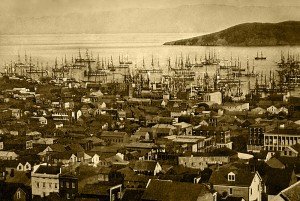
The overland option exposed one to Indian attacks, breakdown on the remote trail or mountains and of course the elements.
In the 1850’s the Indian situation in the west was volatile as diaries from Oregon Trail pioneers detail quite well. One only had to recall the fate of the Donner party in the snow covered Sierra Nevada Mountains.
Steamer to Panama
A trip by steamer via Panama meant a trek through the jungles which also could mean malaria and other afflictions.There was also uncertainty of whether ship passage was available when you finally made your way to the Pacific coast.
Rounding Cape Horn
The third option, a sea voyage around Cape Horn meant two things. Probably a six month journey ( average was about 200 days) and the very good chance of trying to ride out ocean storms not to mention the dangerous passage around Cape Horn. The exception was the Clipper Ship which started the California run in early 1849 and reportedly could make the voyage to San Francisco in about 120 days. It was thought that a regular vessel at the time could make about 4-5 knots where a clipper ship might be able to do 6-7 knots.
The Enticement of Gold
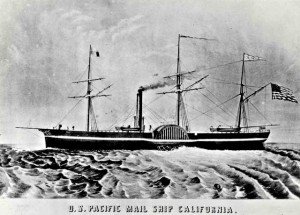
The clipper ships carried mostly valuable freight and not many passengers.
The gold certainly was enticing, the work to get oneself there most likely wasn’t.
Amazingly, people from all walks of life headed to the gold fields. Farmers left their farms, storekeepers closed up their shops, doctors left their practices, clergymen left their flocks and many other people simply left home.
It was reported that in the United States during the year 1849 alone about 42,000 people struck out to California by land and about 25,000 by sea. Another interesting fact is that people from all of the then 31 states headed to the gold fields as well as people from 25 different nations.
Sailing to the Gold Fields
Let’s just say you really were hit with the gold bug and decided to journey to California from the American east coast in 1849 or 1850. Some bought passage on the next steamer bound for the Pacific and others actually signed on as seamen to gain passage west. There was another endeavor which was the creation on cooperatives to send vessels to California. The dual purpose was to journey to the California gold fields and also to carry supplies, if possible, from the east to sell to the thousands now in California.
The Cooperative…One Way to Make the Journey West
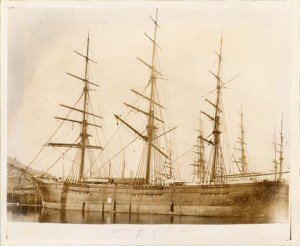
One exceptional story which really illustrates the frantic scramble to make it to the California gold fields concerns the vessel “California Packet“.
Captain George Kimball, working out of the seacoast town of Cutler Maine, lacking the funds to purchase a vessel, went into the Maine woods and cut the timber necessary to build his ship. Kimball’s project became a cooperative.
Meat and provisions were gathered together by farmers who would join the expedition. While other companies were already underway on their voyages to California, Kimball of course was still putting his vessel together. The sheer adventure of such a project as Kimball’s attracted experienced joiners and shipwrights. In place of wages for these workers, shares of the cooperative were issued. The 144 foot long California Packet with a 15 foot beam was finally launched off the Maine coast on November 29, 1849.
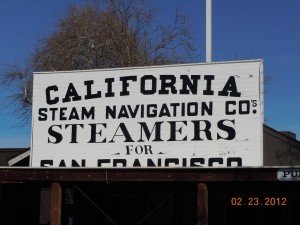
The passengers on this historic voyage were a bit different than those on some of the ships that had departed earlier.
The California Packet carried one hundred people including twelve married women, sixteen unmarried women and fifteen children. The remaining passengers were young males eagerly heading to California to find their fortune.
The wide variety of passengers were most likely due to the ship being a cooperative rather than a commercial vessel simply selling passage. In fact, it was reported that everyone on board the California Packet was a shareholder. The ship was very fortunate to pick up cargo worth some $15,000 in Boston. The vessel sailed around Cape Horn and made safe passage all the way to San Francisco.
California was a wild place in 1850 and while the cooperative worked quite well during the planning stages and during the actual months long voyage, once the ship reached it’s destination the cooperative tended to fall apart. People went their own ways.
Below are links to additional Trips Into History articles you’ll enjoy;
The Amazing Story of the Gold Rush Forty-Eighters
Airships / The California Gold Rush
Dangers Were Always Lurking
The shorter sea route which traversed the Panama jungles had it’s perils. People took sick and died during this crossing. It was not until years later with the completion of the trans-Panama railroad that the dangers were lessened. This shorter route was popular because Cape Horn and the six month sea voyage was avoided. Probably what wasn’t fully realized was the difficulty in crossing through the jungle with the chance of picking up an exotic disease.
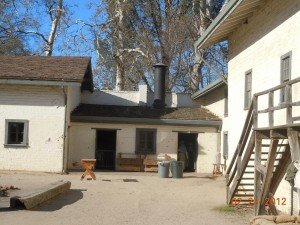
Sea travel required two important things. A competent captain who knew not only how to keep the ship off of rocks but also how to navigate in general. The second thing was to have adequate food supplies. The long voyage to California around Cape Horn required careful planning to either store enough food or know where to stop to replenish the supply. Among diseases on a long voyage was scurvy so fruits were an important food to have along.
The San Francisco Maritime National Historic Park
One of the best ways to learn about the ships of the California Gold Rush is to visit The San Francisco Maritime National Historic Park located adjacent to Fishermans Wharf. For more than 60 years, San Francisco Maritime National Park Association has worked to bring maritime history to life for visitors to the San Francisco Bay Area.
An excellent website to give you a precise chronology of the California Gold Rush years is www.sfmuseum.org
Three books I’d recommend regarding the travel endured, the people involved and the mining towns themselves include Anybody’s Gold: The Story of California’s Mining Towns by author Joseph Henry Jackson, The World Rushed In by author J.S. Holliday and California : Romance of clipper ship and gold rush days by author James W. Travers.
(Photos of Sutters Fort and Steamer Sign is from author’s collection. Remaining photos from the public domain)
